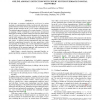Free Online Productivity Tools
i2Speak
i2Symbol
i2OCR
iTex2Img
iWeb2Print
iWeb2Shot
i2Type
iPdf2Split
iPdf2Merge
i2Bopomofo
i2Arabic
i2Style
i2Image
i2PDF
iLatex2Rtf
Sci2ools
ICASSP
2011
IEEE
2011
IEEE
Online anomaly detection with expert system feedback in social networks
In this paper, we propose examining the participants in various meetings or communications within a social network, and using sequential inference based on these participant lists to quickly and accurately predict anomalies in the content of those communications. The proposed approach consists of two main elements: (1) filtering, or assigning a belief or likelihood to each successive measurement based upon our ability to predict it from previous noisy observations, and (2) hedging, or flagging potential anomalies by comparing the current belief against a time-varying and data-adaptive threshold. The threshold is adjusted based on feedback requested from an expert system. In general, parsing communication data can require nontrivial computational resources, but since parsed data is only used sparingly for feedback, the overall computational complexity of the proposed approach is relatively low. Regret bounds quantify the performance of the proposed approach, and experiments on the En...
Enron Email Database | ICASSP 2011 | Nontrivial Computational Resources | Overall Computational Complexity | Signal Processing |
Related Content
| Added | 20 Aug 2011 |
| Updated | 20 Aug 2011 |
| Type | Journal |
| Year | 2011 |
| Where | ICASSP |
| Authors | Corinne Horn, Rebecca Willett |
Comments (0)

